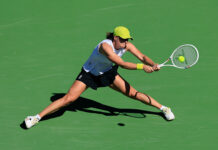Bill Simons
Paris
Even the best among us have issues. Coco Gauff won the US Open and, over the past five years, has won our hearts. She reached No. 1 in doubles, and Monday will be No. 2 in singles.
She thinks about life and shares her ideas. She dances, she giggles, and she is, by some measure, the most charismatic WTA player on the tour.
But she has a problem, a big problem – an Iga Swiatek problem – a conundrum that prompts us to recall Vitas Gerulaitis’s epic 1980 quip, ”Nobody beats Vitas Gerulaitis 17 times in a row.” Gauff’s 10-1 losing record against Swiatek, going in today, was a problem that brought to mind Maria Sharapova, who won five Slams and who got to No. 1, but still had a dismal 20-2 losing record against Serena. It was said it was all so one-sided that the matchup wasn’t really a rivalry.
Neither is the Swiatek vs. Gauff matchup, say many. Going into today’s semifinal in breezy, sunny Paris, the Pole, who has won three French titles, had never lost to Coco on clay. But the proud American 20-year-old fighter was the only player, man or woman, who has reached the semis of the last three Slams.
Still, all of tennis knew that Coco had to come up with something new. Pundits produced a long to-do list for Gauff: be more aggressive, get Iga out of her comfort zone, take her time away, impose your serve, create angles, bring her to net, don’t get stuck in forehand-to-forehand rallies, absorb Iga’s power and redirect her shots, take risks at every point, maintain belief. Or, how about this? Hit every shot on the line.
As if on cue, Iga brushed off two early break points and raced to a commanding 5-1 lead. Coco suffered a slew of errors, and in frustration repeatedly slapped her thigh in frustration. Despite her power and speed, at times she seemed adrift.
Now the issue would be whether Iga would chomp on a breadstick and win the set 6-1. Broadcaster Eleanor Preston quipped, “I feel the fires have been lit at Iga’s bakery. They’re warming up the dough.”
Gauff did manage to win another game before dropping the first set 6-2. But her belief seemed to dip. Still, Coco’s a battler – and she used a dodgy overrule from the ump that brought Gauff to tears to empower her game. At last, early in the second set, the Floridian scored a break. The relieved Coco howled in delight and waved to the French crowd, who were desperate for a close battle.
Match on? Not really. The better player simply reset. Iga flashed her dominating forehand and well-angled laser backhands and promptly broke back, winning five of the next six games.
Yet Coco didn’t give up, and saved three match points. But Iga’s efficient 6-2, 6-4 victory, which took the Pole to her fourth Roland Garros final, had to leave the bright light of American tennis wondering, “What can I do?” Others asked, “How long will Iga go on imposing the pain?”
Coco said she was proud of her run and, as for future battles against Iga, she wasn’t hopeless. She told Inside Tennis that she hasn’t peaked, that there’s room for improvement, and, for now, she will focus on achieving another key goal, winning tomorrow’s women’s doubles semifinal with her considerable partner, Czech Katarina Siniakova.
AN ITALIAN PIZZA PARTY IN PARIS: Prakash Amritraj asked “What are they putting in the pizza over there in Italy?” After all, the 28-year Cinderella, Jasmine Paolini ,crushed the 17-year-old Mirra Andreeva 6-3, 6-1 to advance to the final. Jannik Sinner, who’s now No. 1 in the world, plays Carlos Alcaraz in Friday’s semis, and Italians are thriving in doubles and the juniors.
The 5’ 4” Paolini, who’s the third Italian to reach the French Open final in the open era, will at least rise to No. 7 in the world. What a stunning ascent.
HAPPY TALK: Announcer Mats Wilander to Carlos Alcaraz: “Do you know the one thing you do more than Federer, Nadal and Djokovic?” Carlos: “No.” Wilander: “Smile.”
LIFE’S FRAGILE GIFT – THE 80TH ANNIVERSARY OF D-DAY: On D-Day, 80 years ago, our nation rose up to combat an evil march of madness – a grip of hatred. That same tradition of idealistic courage that prevailed decades ago surely is needed today. Here is our D-Day appreciation.
•••••
Touch the sand, a hard cold plain. Gentle waves break easy, muffling a distant echo within this sea — dark and foreboding.
Lazy lagoons capture still water. A gull swirls free, the sparrow offers a morning song above cruel hills. Waters, so murky, cling to their secrets by this flat, too-wise beach, where a mighty tide was turned.
The surly crimson pools are unseen; still, the knowing sands harbor a bitter truth, beyond our grasp.
This morning, steel clouds hide a horizon like no other; a horizon that wrought a vast gray armada for the ages: 5,423 ships, one goal.
On that day – “The Longest Day” – boys from Moline and Mobile, the sons of Brooklyn and Burbank, Phoenix and Philly, huddled cold in shivering clusters. Wide-eyed, bone-wet, tossed by an uncaring sea – they puffed their last soggy smokes and whispered muted prayers, final invocations before destiny’s dawn.
What unforgiving fear did they feel? What gut-wrenching terror shook their souls before they strode forth – each one to meet his fate?
Some never reached shore. Packed heavy with battle gear, they sank, a fatal stone descending to an unsparing depth.
Some managed just a single step, dropping to that hard beach. Others scaled storied cliffs, subdued bunkers, or trudged on to wage war in the hedgerow maze, emerging to tell tales – a generation’s pride.
Today, the morning wind is cool. But nothing like the chill of horror that gripped the boys of Omaha on that wide, too wide, beach below cruel hills. Wretched little rises that turned into imposing peaks; impenetrable bastions raining fire, tearing flesh – the sea ran red.
Such agony – dreams and destinies ripped asunder – and a shout of death heard by a distant steeple. The mourning dove flees – the world ablaze – chaotic flames tell of the madman’s fury, a potent poison.
So step by terrible step, the battle is fought, the beach is won, a continent is conquered. Step by step, the Nazi knot is undone, and we wake from a twisted dream to again embrace that elusive thread, life’s fragile gift.
COURT’S CURSE: In Melbourne in 2017, Serena Williams won yet another Slam, her 23rd. She was on a roll, and just one major behind Margaret Court’s record of 24. Soon she’d catch and then surpass the often grumpy, controversial Aussie. Piece of cake!
But, hold on. Serena played ten more majors but would never equal Court’s extraordinary achievement. Similarly, at September’s US Open, Novak Djokovic won his 24th major to equal Margaret’s record. Since then, havoc has ensued. Jannik Sinner scored two signature wins over him in the fall. Nole faltered at the Davis Cup and the Aussie Open. He fired his coach, fitness trainer, manager and publicist. He fell to No. 123 Luca Nardi at Indian Wells. He got conked on the head by a water battle at the Italian Open and came into the French Open without having won a title (or even reaching a final) in 2024.
In Paris, he did set a bunch of records, including the latest ever Roland Garros finish. That’s what the Serb does. But Nole also spoke of dealing with a Pandora’s box of private problems he would not delve into publicly.
Fans were stunned to see his wife barking at him on court. We imagined her words: “Hey, sweetie, get it together!” And, as we know, Novak suffered a devastating meniscus tear, had to have surgery earlier this week, and lost his No. 1 ranking. Almost certainly he’ll miss Wimbledon, and probably the Olympics.
All of which begs the question: can the magical mountain man from Serbia somehow counter Court’s curse and win a record-setting 25th Slam?
THE POWER OF PLAYING TENNIS WITH FREEDOM: When Inside Tennis asked young Mirra Andreeva what her greatest strength was, the 17-year old replied, “I would say I always play the way I want to play. My coach [Conchita Martinez] and I have a plan, [but] I forget everything, and when I play I don’t have any thoughts in my head. So maybe I would say that my strength could be that I just play how I want to play and I do whatever I want to do – and maybe this helps me when I play.”
She added, “For example, Sabalenka plays a forehand crosscourt, I have time to see where she’s standing, where she’s waiting for my ball to go, and then I decide, ‘Well, what should I do? Should I go down the line or should I do cross, should I do a dropshot, should I do a lob?’ [But] that’s sometimes not really good because I have a lot of decisions in my mind. When I change them at the last moment, always some kind of crap happens…Sometimes it plays that bad joke on me. So I’m trying to keep it simple, but I cannot help it. Sometimes I just have too many decisions in my head. But I would say that I play shot-to-shot mostly.”
LESS IS MORE: The average height of today’s semifinalists was 5’ 8.” Swiatek, Gauff and Andreeva are all 5’ 9.’
AGE GAP: The semifinal between 28-year-old Jasmine Paolini and 17-year-old Mirra Andreeva was the biggest age differential between two women facing each other in a French Open semifinal since 30-year-old Chris Evert defeated 15-year-old Gabriela Sabatini in 1985.



















